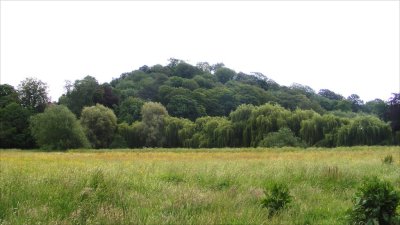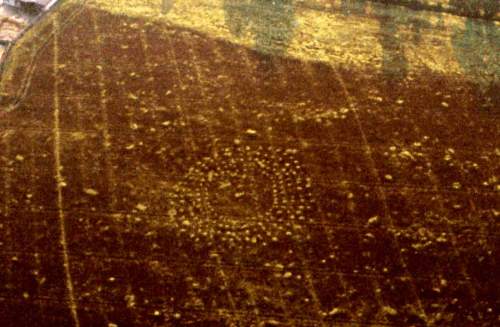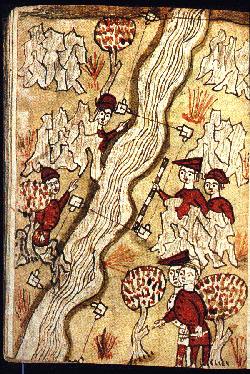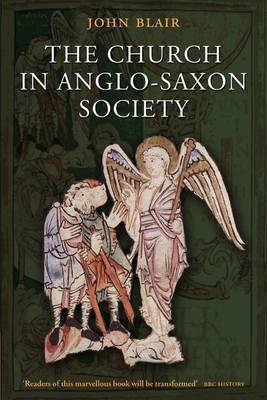The next seminar in my backlog pile is not about Anglo-Saxon England, it being when Marie Legendre spoke to the Institute of Historical Research Earlier Middle Ages Seminar on 27th February 2013 with the title, “Neither Byzantine nor Islamic? The Dukes of the Thebaïd and the Formation of the Umayyad State”, and that was really interesting, but the thing is, I’m fourteen months behind with these posts and Magistra et Mater already covered that one. So I thoroughly recommend you go and look at that, and meanwhile I will write some more about John Blair’s Ford Lectures. But what? I hear you say. You dealt with the last one only four posts ago! True, but there is, it transpires, also a Ford Lecturer’s Seminar, in which the year’s lecturer is invited to discuss his findings with his audience, and that happened on 1st March 2013 with the same title as the lecture series, “Building the Anglo-Saxon Landscape”, and I was there.

Poster for John Blair’s Ford Lectures, 2013
The format this took is that John had distributed a handout that gave a seven- or eight-point summary of each lecture and then after a very short introduction simply took questions for an hour, and whatever discussion kicked off out of them was followed as far as it led. There were certainly lots of people with questions to ask, but the biggest focus of interest was on the organisation and planning of settlements for which John was arguing in the Anglo-Saxon world. In particular there was discussion about the shift of paradigm that he had proposed from central places to central zones: I wondered how much the concentration of sites in such zones differed from that outside them, to which John said that the important thing might not be concentration so much as the links between the sites, and Mark Whittow wondered if the burh in these complexes of sites wasn’t still the centre, to which John countered that as far as he could see the different elements in these complexes were as important as each other in as much as none of them shared functions, so were all indispensable to the whole. As Mark said, there’s a model here that could work in a number of other places where someone was organising the landscape to this much effect.1

Scalpecliffe Hill, Stapenhill, supposed site of the hermitage of St Modwenna and certainly site of an Anglo-Saxon cemetery, just across the River Trent from Burton-on-Trent
That leads us onto the other question that really had people going, which was that of who was organising these landscapes and how. John had argued, as part of his section on the grid-planning he had detected in many Anglo-Saxon settlements, that the key knowledge involved here was probably preserved and transmitted through monasteries, but of course monasteries were themselves large landowners so it was hardly locked away, and their links to the nobility and to kings were such that their knowledge would have been available for most of the people we can imagine planning sites. Nonetheless, we see little if any such sign of organised planning in the early trading ports or wics that have long been seen as the lynchpins of economic development in middle Saxon England and whose organisation is usually attributed to the kings.2 John pointed out that some of Hamwic, the site of this type across the River Itchen from modern Southampton, was in fact gridded, but reckoned that this was probably a monastery within the town.
This bit of the discussion didn’t really reach a conclusion that my notes record but John was again keen to emphasise chronology in what he saw, in as much as while settlement gridding was for him a phenomenon of the eighth and late-tenth-to-eleventh centuries, and often very short-lived indeed, to the extent that he thought it might have been more symbolic than functional (very interesting), the basic organisation of settlements as dispersed houses each with their infield for cereals and outfield for animals goes on throughout and doesn’t change until well after the various things that are supposed to kick off economic take-off in the tenth century. That take-off thus precedes the things that English historians have tended to blame for England’s medieval economic miracle, open-field settlements and three-field crop rotation, but the change in settlement pattern does coincide with that, in the eleventh and twelfth centuries primarily.3

Reconstruction drawing of ninth-century Stafford; note the shape of the enclosure. I think someone involved may have been present at these lectures…
There were also smaller issues raised: Lesley Abrams wondered about the spread of the ‘egg-shaped’ fortified sites John had detected in the later part of his study period and their relation to the villages of which they were part, to which John responded that so far they were all in the East Midlands (though we know that Allan McKinley thinks others could be found further west…) but that their relationship to villages differed a great deal, being built on top of them, within them or outside them; this may be a matter of their functions, which are not yet clear. There were also a number of questions about minsters as centres of organisation which didn’t really add anything to what John has already written on the subject.4

A reconstructed Anglo-Saxon house at East Firsby, Lincolnshire, of a typical type that may be one of the few things that seems to have transmitted from British to Anglo-Saxons; image from Wikimedia Commons
The other question, that might in some ways be the biggest one, was that of the West. Most of what John had discovered in the archæology was at its most evident in what he had termed the Wash Catchment; this is good in as much as our texts favour the South and the North and not the Midlands, but the West Midlands, the North-West and anywhere British had still been very much missing from these lectures, and that basically because material culture remains have been far less frequently discovered there. To some extent, this is a matter of lowland versus highland with the economic intensification possible in the one leading to scales of wealth and structure not visible in the other, but since John had been at pains to stress that much of Anglo-Saxon wealth was expressed in portable and transient forms, and the British West was no stranger to such goods, there’s still some mysterious gaps to account for. John’s work and that of others have already taken some steps to guess what’s in those gaps, but gaps they remain, and yet as you know if you’re a long-term reader I feel that these zones, where British met English and held them off for quite some time in some cases, must be an important part of the story of how the one became the other and I wish more would come out of them to make that story possible to tell.5
1. Of course, one could argue that this model was already out there in the form of Glanville Jones’s concept of multiple estates, in his “The multiple estate: a model for tracing the interrelationships of society, economy, and habitat” in Kathleen Biddick (ed.), Archaeological approaches to medieval Europe (Kalamazoo 1984), pp. 9-41, and Rosamond Faith raised this; John’s counter here was that Jones argued essentially for the long-term survival of Roman settlement organisations with devolved functions, whereas John sees a wave of new creation of such sites from the eighth century onwards.
2. The basic integration of wics into a scheme of history is still that of Richard Hodges, Dark Age Economics: the origins of towns and trade A D. 600-1000 (London 1982, 2nd edn. 1989); cf. relatively current discussion in Tim Pestell & Katherine Ulmschneider (edd.), Markets in early medieval Europe: trading and ‘productive’ sites, 650-850 (Macclesfield 2003) or Mike Anderton (ed.), Anglo-Saxon Trading Centres: beyond the emporia (Glasgow 1999).
3. E. g. the unquestioning use of this paradigm in C. T. Bekar & C. G. Reed, “Open fields, risk, and land divisibility” in Explorations in Economic History Vol. 40 (Amsterdam 2003), pp. 308-325, DOI: 10.1016/S0014-4983(03)00030-5; cf. the various international perspectives presented in La croissance agricole du haut moyen âge : chronologie, modalités, géographie. Dixième Journées Internationales d’Histoire, 9, 10, 11, Septembre 1988, Flaran Vol. 10 (Auch 1990).
4. In J. Blair, The Church in Anglo-Saxon Society (Oxford 2005), more or less passim to be honest.
5. Christopher Snyder, An Age of Tyrants: Britain and the Britons, A. D. 400-600 (Stroud 1998); Steven Bassett, “How the West Was Won: the Anglo-Saxon takeover of the West Midlands in Anglo-Saxon Studies in Archaeology and History Vol. 11 (Oxford 2000), pp. 107-118; J. Blair, The British Culture of Anglo-Saxon Settlement, H. M. Chadwick Lecture 24 (Cambridge 2013); Chris Wickham’s vision of Britain in this period in Wickham, Framing the Early Middle Ages: Europe and the Mediterranean, 400-800 (Oxford 2005), pp. 306-333 & 339-364, rather involves assuming that these zones did not impede access of English to British and this is one of the few places where I think that book’s ideas might need revision.






































